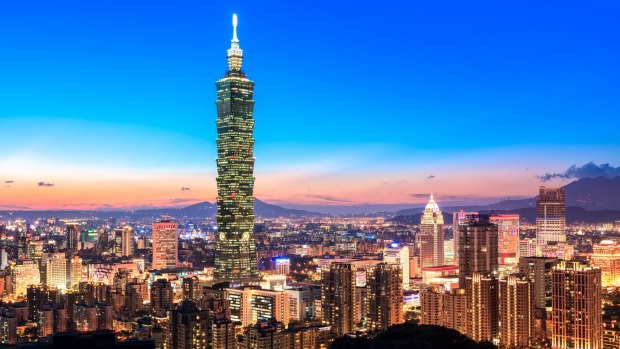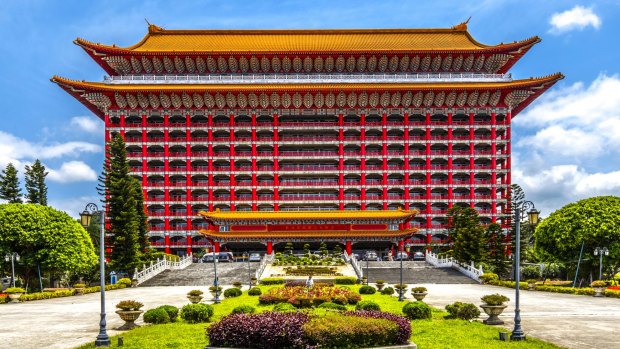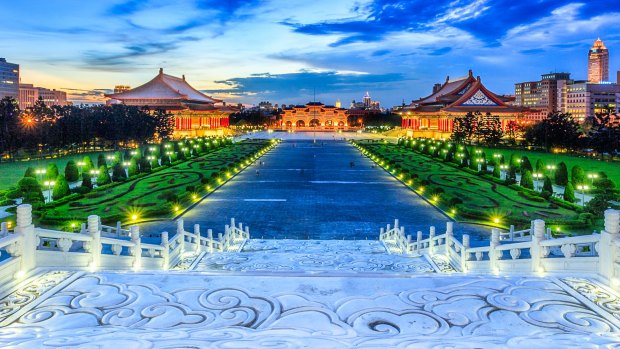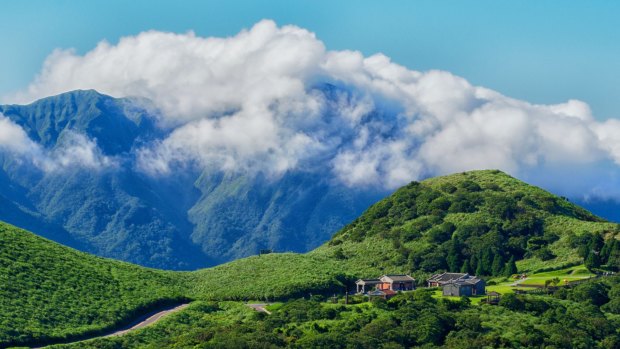This was published 4 years ago
Taipei travel guide: 10 things to know about Taiwan's capital
By Mark Daffey

Taipei World Trade Center and Taipei 101 in Xinyi Business District at dusk.Credit: iStock
I WANT TO GET MY BEARINGS
The 525-metre-high Taipei 101 – the 101 refers to the number of levels – stretches towards the heavens like a giant beanstalk. Ranking as the world's tallest building until Dubai's Burj Khalifa nudged it off its mantel in 2010, it incorporates traditional design elements representing a bamboo (not bean) stalk and an Asian pagoda. A spherical steel pendulum suspended between the 92nd and 87th floors counterbalances movements caused by wind gusts and tremors in this typhoon and earthquake-prone region.
Boutique fashion houses, a food court and several restaurants (try the dumplings and "small eats" in Din Tai Fung) fill its lower levels. But it's from the indoor and outdoor observation decks, on the 89th floor and 91st floors, that you can grasp the city's layout, sprawling along multiple river valleys towards a surrounding ring of mountains. Both observation decks are accessible via one of the world's fastest elevators.

The Grand Hotel is a landmark located at Yuanshan in Zhongshan District, Taipei.Credit: iStock
I WANT TO GET PHYSICAL
The best views over the city – including Taipei 101 – are from Elephant Mountain. Getting there requires a thigh-burning 20-minute hike up a coiling stairway through the leafy Xiangshan neighbourhood, close to the Xinyi shopping district and Linjiang Street Night Market.

Chiang Kai Shek Memorial Hall in Taipei honours the general who was Taiwan's president until 1975. Credit: GoranQ
Several lookouts are spread out across varying levels, so find a free space and settle in. The best known of these is the Six Giant Rocks Lookout. Time your visit for late afternoon and you can catch the colours of sunset, then watch the city light up at night.
I WANT TO SEE MEN IN UNIFORMS

The Yang Ming Shan national park.Credit: iStock
Sun Yat-Sen and Chiang Kai-Shek are the two seminal figures in Taiwan's modern history. Sun Yat-Sen became Taiwan's first President in 1912 and is considered its founding father. Chiang Kai-Shek was President of Taiwan (officially known as the Republic of China) from 1950 until his death in 1975.
Both political figures are honoured with oversized bronze statues inside cavernous memorial halls, where Changing of the Guards ceremonies take place hourly from 9am to 5pm each day. These are popular stopovers on tourist bus itineraries, so try to arrive at least 15 minutes early to claim a good viewing space.
See en.yatsen.gov.tw and cksmh.gov.tw
I WANT A SPIRITUAL FIX
Architectural flourishes are a rare sight in Taipei, though hidden gems exist in the form of several age-old temples mixing Buddhist, Tao and Confucian beliefs. Taipei's oldest temples are found in Wanhua District, close to the Danshui River, and all possess exquisite decorative stone and woodcarvings. But like places of worship the world over, their voyeuristic elements are equally fascinating.
The 280-year-old Longshan (Dragon Mountain) Temple is undoubtedly Taipei's spiritual showpiece and the only one with bronze pillars. Two others are Qingshan and Tianhou, dating back to 1856 and 1746 respectively. Both are authentic places of worship, with thinner crowds than those at Longshan, making for arguably more intimate experiences.
I WANT TO SEE HISTORICAL ARTEFACTS
The National Palace Museum contains the world's largest collection of Chinese art treasures. Most of the collection was part of the imperial collection in Beijing's Forbidden City, but was freighted over for safekeeping during the Chinese Civil War.
Only a small percentage of the museum's 600,000 artefacts – some dating back 8000 years – are on display at any one time, spread over four floors and two exhibition halls. The most popular exhibits, called the Three Treasures, are a bronze cauldron, a jadeite cabbage and a stone carving shaped like a piece of stewed pork. An Australian equivalent would be a Big Chiko Roll.
Keep in mind that it can get very crowded; the museum is one of the most visited in the world. Mondays, as well as Friday and Saturday evenings, are considered the quietest times.
See npm.gov.tw
I WANT A HOT BATH
Significant geothermal activity occurs beneath the mountainous Yangmingshan National Park that borders Taipei's northern outskirts. These underworld forces bubble to the surface in the form of hot springs, steaming fumaroles and odorous sulphur deposits.
During the Japanese occupation, this area around the district of Beitou developed into a resort destination filled with hotels, tea houses and public baths. Rules around gender separation, modesty and etiquette still apply.
I WANT A SHOT OF NOSTALGIA
There are better hotels in Taipei, though none share the hallowed history of the Grand Hotel. The Grand opened in 1973 under orders from then president Chang Kai-Shek, who worried that visiting dignitaries would be underwhelmed by the city's accommodation offerings.
Taipei's first five-star hotel commands its location, on a rise looking south over the Shilin area, close to Beitou's Thermal Valley. Since Taiwan wasn't a member of the United Nations at the time, the blueprints included an escape tunnel - now open for viewing by guests.
See grand-hotel.org
I WANT TO EAT AUTHENTIC TAIWANESE FOOD
Skip Taipei's many excellent restaurants and cafes, and instead snack on sticky tofu and bubble tea while you walk between aisles and food stalls at one of Taipei's famed night markets.
The biggest and best is Shilin, where hundreds of food stalls operate shoulder to shoulder in a maze of covered alleyways. Every wok and pan-fried dish you've ever imagined – and many more – are cooked in front of you. You may recognise some noodle dishes and tempuras, but otherwise just point and try, sampling bits and pieces until you can't squeeze in another morsel.
Other night markets include Ningxia and Huaxi, and Raohe and Linjiang streets. Often, they are more than just food markets, being located down the centre of shopping strips where retail stores stay open until well after midnight.
I'M IN THE MOOD FOR DANCING
The Dream Parade has become a free annual spectacle since it first stormed the streets in 2001. Scheduled to take place on the third Saturday of October, it commences beneath the Chiang Kai-Shek Memorial Hall gates at 3pm and culminates three hours later outside the Ministry of Foreign Affairs building on Ketagalan Boulevard.
Drawing on influences from New Orleans' Mardi Gras, Rio's Carnival and Nevada's Burning Man Festival, among others, the parade attracts giant papier-mache puppets, stilt walkers, laughing yoga clowns and floats up to three storeys high. Specialist artists from all around the world are invited to the event and a samba drumming competition features school children drawn from aboriginal villages around the nation.
ONE MORE THING
The Taiwanese have traditionally written messages of hope on lanterns then released them into the sky, praying that their wishes will be fulfilled. It's a tradition that lives on through the Taiwan Lantern Festival, which has taken place around the Chinese New Year for the past 30 years.
Blending the best of traditional lantern making with high-tech innovation around a central theme, the festival attracts well over a million spectators. While the festival was staged outside the Chiang Kai-Shek Memorial Hall for the first 11 years of its life, counties around the country now bid against each other for the honour of hosting the event. Taichung will host the 2020 Lantern Festival from February 8. The theme will be Fantasy Forest.
I WANT THE FACTS
POPULATION
2.7 million
LOCATION
Taipei is in the northern part of Taiwan, 20 kilometres inland from the Danshui River mouth at Fisherman's Wharf, in a basin between the Yangming and Central Mountains.
CLIMATE
Taipei enjoys warm, humid weather year round. Weather conditions during spring and winter can fluctuate, while summer and autumn are relatively stable. Drizzling rain is common from March to May, while tropical typhoons sometimes lash the city between June and August.
ARCHITECTURE
Taipei is a jumble of grimy, occasionally crumbling multi-storey office and apartment blocks as grey as the sky above them, with very little by way of inspiring modern architecture. Taipei 101, the Taiwan Sports Arena and the spherical Financial Centre are notable exceptions.
ACCOMMODATION
Rooms at the amba Taipei Songshan hotel start from $110 a night on a 21-day advance purchase plan. Conveniently, the Raohe Street Night Market is just down the road.
See amba-hotels.com/en/songshan
MORE
Mark Daffey was a guest of the Taiwan Tourism Bureau.
Sign up for the Traveller Deals newsletter
Get exclusive travel deals delivered straight to your inbox. Sign up now.